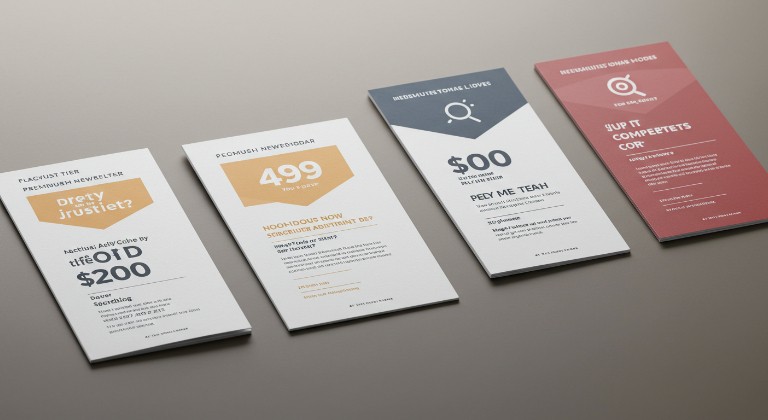Introduction
Imagine having a subscription list so compelling that your audience happily pays for exclusive content. Sounds like a dream, right? Well, welcome to 2025—the golden age of newsletter monetization. From SaaS-inspired pricing models to high-value premium tiers, there’s no shortage of strategies to turn your email list into a thriving business. In this blog, we’ll dive deep into creating premium newsletter tiers and effective pricing strategies tailored to meet your audience’s needs while maximizing revenue. Ready? Let’s get started.
Let me paint you a picture. Imagine opening your inbox every morning to discover new subscribers, each eager to invest in the premium insights you’ve curated. That’s the power of a well-executed newsletter strategy. In today’s digital landscape, newsletters are more than just emails; they’re dynamic tools for building community and generating steady income streams. The best part? You don’t need to be a tech wizard to make it happen. With the right approach, anyone can create a sustainable and profitable newsletter business.
Table of Contents
What Are Premium Newsletter Tiers, and Why Should You Offer Them?

Think of premium newsletter tiers as a Netflix subscription for your email. Instead of offering a one-size-fits-all approach, you provide multiple levels of content—each priced according to the value it delivers.
Why does this matter?
- Cater to Different Audiences: Some readers want free content; others are willing to pay for exclusivity.
- Revenue Diversification: Tiered pricing lets you capture more value from your audience.
- Upselling Opportunities: Moving subscribers up the ladder from free to premium becomes seamless.
- Retention and Loyalty: Offering premium options keeps your most engaged subscribers happy and invested.
Here’s a simple analogy: if free content is the appetizer, your premium tiers are the gourmet main course. Tempting, isn’t it? Plus, the data doesn’t lie—more creators are adopting this model and seeing tangible results. By offering tailored experiences, you not only meet diverse audience needs but also future-proof your revenue streams.
How Do You Determine the Right Pricing for Newsletter Tiers?
Pricing isn’t one-size-fits-all; it’s part art, part science. Here are actionable steps:
- Understand Your Audience: Conduct surveys or use analytics tools to learn how much they’re willing to pay. Look at engagement rates and determine which segments value premium content the most.
- Benchmark Against Competitors: Research other newsletters in your niche. What are they charging? What unique value can you provide to justify your pricing?
- Align Value with Price: If your highest tier includes exclusive reports, live webinars, or behind-the-scenes insights, justify a premium price. Transparency about what’s included builds trust.
- Experiment with A/B Testing: Test different pricing models to see which resonates best with your audience. Don’t shy away from adjusting prices based on feedback—flexibility can be a game-changer.
Example Table: Pricing Model Comparisons
| Tier | Features | Monthly Price | Annual Price (Discounted) |
|---|---|---|---|
| Free | Weekly digest, limited articles | $0 | $0 |
| Basic | Ad-free experience, bonus content | $5 | $50 |
| Premium | Exclusive reports, webinars | $15 | $150 |
| VIP/Elite | 1:1 consultations, live Q&A | $50 | $500 |
A well-structured pricing table not only communicates your offer clearly but also nudges users toward the best value tier. Pro tip: Highlight the most popular option to guide decision-making.
What Features Should You Include in Each Tier?
Content is king, but it’s also the joker if poorly executed. Here’s how to deliver value at every tier:
- Free Tier: Tease with high-quality yet limited content (e.g., weekly updates, curated news).
- Basic Tier: Add exclusivity—bonus articles, early access to content, or ad-free browsing.
- Premium Tier: Dive deeper—offer research, detailed guides, video content, or expert interviews.
- Elite Tier: Personalize the experience with one-on-one sessions, VIP perks, or access to live events.
Remember, it’s not just about quantity but quality. High-value content doesn’t have to mean more; it means better. Tailor each tier to specific audience needs and ensure premium subscribers feel they’re getting a return on investment.
How Can You Market Premium Newsletter Tiers Effectively?
Marketing makes or breaks your tiered newsletter strategy. Here’s how you can ensure success:
- Leverage Social Proof: Highlight testimonials, case studies, or user success stories to build credibility.
- Show Value Upfront: Offer a free trial or discounted first month. Let potential subscribers experience the value firsthand.
- Create FOMO: Use limited-time offers or early bird discounts for premium tiers. Scarcity drives urgency.
- Utilize Platforms Like Substack or Patreon: These tools simplify subscription management while enhancing user experience.
- Email Marketing: Use segmentation to pitch the right tier to the right audience. For instance, send tailored messages showcasing how a higher tier matches a subscriber’s preferences.
- Content Previews: Tease premium content in free tiers to entice upgrades. Think of it as a movie trailer—short, impactful, and irresistible.
Tools and Platforms for Managing Tiered Pricing

Having the right tools can save you a ton of time and headaches. Here are some top recommendations:
- Substack: Easy setup for paid and free newsletters. Known for its seamless user experience.
- Patreon: Great for offering tiered memberships with exclusive perks. Perfect for creators who want to diversify.
- ConvertKit: Ideal for creators looking to monetize email lists. Offers robust segmentation features.
- Mailchimp: Excellent for managing large lists and segmenting free vs. paid subscribers.
- Ghost: An open-source platform with built-in membership options, ideal for premium newsletters.
- Kajabi: A powerhouse for selling memberships and courses, with full customization.
- Revue: Integrated with Twitter, making it a breeze to reach your social media audience.
Using tools that align with your goals ensures you spend less time on logistics and more time crafting stellar content.
Balancing Free vs. Paid Tiers Without Alienating Free Subscribers
It’s a delicate dance. Here’s how to balance it:
- Don’t Neglect Free Content: Your free tier should still provide value. Think of it as a gateway to your premium offerings.
- Clearly Differentiate Tiers: Highlight what paid users get that free users don’t. Use visuals or tables to illustrate the differences.
- Upsell Gently: Use in-content teasers for premium content. For instance, “Enjoying this guide? Premium subscribers get full access to our in-depth analysis.”
- Show Appreciation: Engage with free subscribers through polls, Q&As, or exclusive sneak peeks. A loyal free base often converts to paid.
Conclusion
Creating premium newsletter tiers isn’t just about adding paywalls; it’s about understanding your audience and delivering value at every level. With the right pricing strategy, tools, and marketing approach, your newsletter can become a significant revenue driver.
What’s stopping you? Start building your tiered subscription model today and watch your newsletter thrive. Need help choosing the best tools or setting up your strategy?



